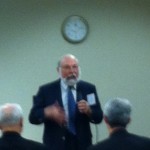
I knew absolutely nothing about Pauline Jaricot (the last name is pronounced Jericho) until last Saturday, January 26th. I learned about Pauline through my friend, Sister Madge Karecki. Madge, who directs the office of mission for the archdiocese of Chicago, invited me to a special day of celebration for Pauline’s life. This event, held on the south side of Chicago at the Cardinal Meyer Center, included the presentation of the first ever “Pauline Jaricot Award.” The award given to a Polish priest who is serving a parish in the archdiocese of Chicago. The story of Pauline was powerfully told by Sister Madge to a small gathering. The award was then presented.
Fr. Roger Schroeder, Professor of Intercultural Studies and Ministry and holder of the Bishop Francis X. Ford, M.M., Chair of Catholic Missiology, at Catholic Theological Union, then gave one of the finest “basic” presentations on Catholic missiology I’ve ever heard. His presentation was taken from his excellent book, What is the Mission of the Church? A Guide for Catholics (2008). 
Back to Pauline Jaricot, this amazing lady who lived in the 1800s in France. Pauline was moved during her teen years to confess her sin and turn to Christ as her Savior. She would later help to usher Catholic missions into a new age. Her vision, through her amazing God-given charism and faithfulness, still impacts Catholic mission down to the present time.
In her early teen years Pauline enjoyed dancing and glamorous balls. At 15 she took a serious fall and through this crisis was brought to a clear conversion experience. She rightly said of herself, “God gave me a faithful heart, which could be easily stirred to piety.” After her conversion Pauline had a vision of two lamps. One lamp was empty, the other overflowing. The empty lamp represented France as a dying culture in the wake of the French Revolution. It revealed, to Pauline’s understanding, the nominal Catholicism of her age. She understood the second lamp to represent the faith of newer Christians in far away mission places. She prayed that their piety and faith would spill back over her homeland, thus enriching the lives of believers in France.
Pauline’s brother went off to seminary and there learned about the work of the Paris Mission Society in Asia. He asked Pauline to try and raise funds for these missionary efforts. She responded by saying, “I want to be a missionary of the love of God throughout the world.” During this time her sister took her to church where the priest spoke about the danger of vanity. Pauline’s heart was deeply touched and she went to confession. She resolved to destroy her romantic novels and expensive jewelry and seek the Lord with all her heart. As she resolved to serve more earnestly she began to visit those driven into poverty by the failure of the new bourgeoisie class to pay them a just wage. By this point in her life she was engaged in heart piety and love for people at the same time.
In 1819 Pauline began a mission of daily prayer for missionaries. She also created circles of ten to make a small weekly contribution of money for mission. By 1820 she had over a thousand people in her circles of ten. The leaders of the Church wanted her to support works in China but Pauline had an added burden for the Louisiana Territory in America. The clergy initially opposed Pauline’s work but her brother encouraged her and the Society for the Propagation of the Faith eventually spread throughout the world. The Central Committee could do nothing to stop Pauline’s faithful work even though it did not fit with their plans and ideas. Her spiritual guide, John Vianney, became her confessor and advocated that she trust in the Lord and practice deeper adoration. She later said, “The mystery which surrounds my affairs is the mystery of the cross.”
Sister Madge Karecki ended her moving tribute to Pauline Jaricot last Saturday by telling us about the core elements of Pauline’s message, a message that eventually caused church leaders to change their attitudes toward her and her deeply-missional ideas. When you hear these core elements about her life and mission you have to conclude, Catholic or Protestant, that this amazing woman had a missional vision long before we had a theology that lined up with the doctrine of the trinity and the nature of God’s love like we have today. Here are the elements of Pauline’s faith and how she lived it out over 165 years ago:
- Fall in love with Christ deeply and allow his love to work itself out within you and through you.
- Live in a way that gives witness to Christ’s love for all people.
- Appreciate the riches of the Church’s life and live your faith with true zeal.
- Live out your baptismal call to mission.
- Stay close to poor people.
- Have a heart for the world and support missionary efforts to the whole world.
Related Posts
Comments
Comments are closed.
My Latest Book!

Use Promo code UNITY for 40% discount!







Wendy Heusel liked this on Facebook.
James H Kim liked this on Facebook.